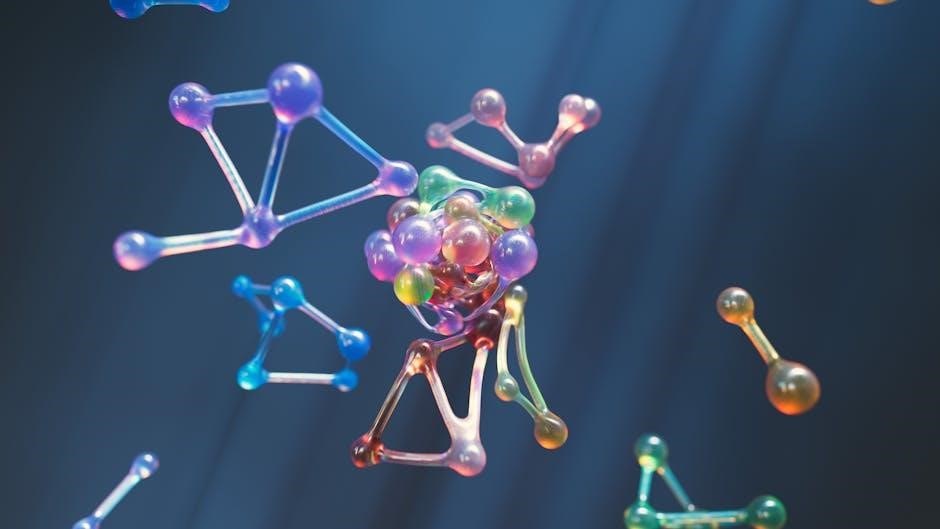
Physical chemistry explores the molecular basis of chemical phenomena, connecting macroscopic observations with microscopic interactions. This approach emphasizes understanding molecular structures and dynamics to explain chemical processes visually and quantitatively.
1.1 The Importance of Molecular Approach in Physical Chemistry
The molecular approach in physical chemistry provides a framework for understanding chemical phenomena at the most fundamental level. By focusing on molecular interactions and dynamics, it bridges the gap between macroscopic observations and microscopic explanations. This approach is essential for explaining complex processes, such as chemical reactions and phase transitions, by breaking them down into molecular-level events. It allows chemists to predict and manipulate the behavior of substances under various conditions, enabling advancements in fields like materials science and drug design. The molecular perspective also fosters interdisciplinary connections, integrating concepts from quantum mechanics, thermodynamics, and statistical mechanics. Ultimately, this approach equips researchers with the tools to design and optimize systems at the molecular scale, driving innovation in both theoretical and applied chemistry.
1.2 Historical Development of Physical Chemistry
Physical chemistry emerged as a distinct field in the 19th century, driven by the integration of chemistry with physics and mathematics. Early milestones included the development of thermodynamics, electrochemistry, and chemical kinetics. Key figures like J. Willard Gibbs and Svante Arrhenius laid the groundwork for understanding chemical equilibria and reaction rates. The 20th century saw the rise of quantum mechanics, which revolutionized the molecular approach, enabling precise descriptions of atomic and molecular behavior. Advances in spectroscopy and computational methods further enhanced the ability to study molecular interactions. These developments have allowed physical chemists to explore complex systems, from biological molecules to materials science, fostering interdisciplinary research. The historical evolution of physical chemistry underscores its role as a bridge between fundamental theory and practical applications, shaping our understanding of the molecular world.
Quantum Mechanics in Physical Chemistry
Quantum mechanics provides a theoretical framework for understanding molecular behavior, offering insights into atomic and molecular structures through principles like wave functions and probability distributions, essential for modern chemical modeling.
2.1 Key Concepts of Quantum Mechanics
Quantum mechanics introduces fundamental concepts that explain molecular behavior at the atomic and subatomic level. Key ideas include wave-particle duality, where particles like electrons exhibit both wave-like and particle-like properties. The Heisenberg Uncertainty Principle highlights the impossibility of simultaneously knowing a particle’s position and momentum with high precision. Quantum tunneling describes how particles can pass through energy barriers, defying classical physics. Additionally, the concept of quantization states that energy levels in atoms and molecules are discrete, leading to specific energy transitions observable through spectroscopy. These principles form the foundation for understanding molecular structure, bonding, and reactivity, making quantum mechanics indispensable in modern physical chemistry.
2.2 The Schrödinger Equation and Its Significance
The Schrödinger Equation is a cornerstone of quantum mechanics, providing a mathematical framework to describe the time-dependent behavior of quantum systems. In physical chemistry, this equation is pivotal for understanding molecular dynamics and energy states. By solving the Schrödinger Equation, researchers can determine the wave function of a system, which encodes probabilistic information about particle positions and energy levels. The equation incorporates the Hamiltonian operator, representing the total energy of the system, and is essential for predicting molecular properties such as bond lengths and vibrational frequencies. Its significance extends to applications in thermodynamics and spectroscopy, where it aids in calculating thermodynamic properties and understanding energy transitions. Furthermore, computational chemistry relies heavily on the Schrödinger Equation for molecular modeling, enabling the design of new materials and the study of reaction mechanisms. Thus, it is a foundational tool for advancing molecular-level understanding in chemistry.

Molecular Structure and Bonding
Molecular structure and bonding are central to understanding how atoms interact to form molecules. This section explores the principles governing molecular geometry, bond formation, and the resulting chemical properties.
3.1 Atomic Orbitals and Hybridization
Atomic orbitals are mathematical descriptions of the regions where electrons are most likely to be found in an atom. These orbitals have specific shapes, such as s, p, d, and f, which influence how electrons are distributed. Hybridization occurs when atomic orbitals combine to form new hybrid orbitals with unique geometries, enabling atoms to form covalent bonds. This concept is fundamental in understanding molecular geometry and bonding. For instance, sp³ hybridization in carbon leads to tetrahedral structures, while sp² and sp hybridizations result in trigonal planar and linear geometries, respectively. The mixing of atomic orbitals is crucial for explaining the formation of sigma and pi bonds, which are essential for chemical bonding. This section delves into the principles of orbital hybridization and its role in determining molecular shapes and bonding patterns, providing a foundation for understanding chemical reactivity and molecular interactions.
3.2 Molecular Orbitals and Chemical Bonding
Molecular orbitals (MOs) are formed by the combination of atomic orbitals from individual atoms, creating new energy levels that are characteristic of the molecule as a whole. These orbitals determine the distribution and energy of electrons within a molecule, influencing its chemical bonding and stability. The formation of molecular orbitals involves both bonding and antibonding interactions, which affect the overall bond order. The filling of molecular orbitals follows the same principles as atomic orbitals, adhering to the Aufbau, Pauli exclusion, and Hund’s rules; Understanding molecular orbital theory is crucial for explaining the electronic structure of molecules, their spectroscopic properties, and their reactivity. This section explores the principles of molecular orbital formation, their energy levels, and their role in chemical bonding, providing insights into the electronic basis of molecular behavior and chemical reactions.

Thermodynamics: A Molecular Perspective
Thermodynamics examines energy transformations at the molecular level, revealing how molecular interactions influence properties like internal energy and entropy, and their role in chemical systems and processes.
4.1 Laws of Thermodynamics
The laws of thermodynamics form the foundation of understanding energy and its interactions at the molecular level. The zeroth law introduces the concept of temperature and thermal equilibrium, while the first law emphasizes the conservation of energy, linking work and heat transfer. The second law explores entropy, a measure of disorder, highlighting the direction of spontaneous processes. These principles collectively govern how energy is transformed and distributed within molecular systems, providing a framework to predict the feasibility and outcomes of chemical reactions. By analyzing thermodynamic laws, physical chemists gain insights into the energetics and stability of molecules, essential for understanding chemical behavior and designing efficient processes.
4.2 Thermodynamic Properties at the Molecular Level
Thermodynamic properties at the molecular level provide insights into how energy and matter interact within chemical systems. Key properties include internal energy, entropy, and Gibbs free energy, which describe the energetic state of molecules. These properties are derived from the behavior of individual particles and their interactions, offering a microscopic perspective on macroscopic phenomena. Statistical mechanics plays a crucial role in relating molecular-level dynamics to bulk thermodynamic observations. By analyzing these properties, physical chemists can predict phase changes, reaction spontaneity, and the stability of molecular structures. Understanding thermodynamic properties at the molecular level is essential for designing efficient chemical processes and materials, as it allows for precise control over energy distribution and transformation.

Chemical Kinetics and Reaction Dynamics
Chemical kinetics examines reaction rates and mechanisms, while reaction dynamics studies molecular interactions during processes. Both fields are crucial for understanding and controlling chemical transformations at the molecular level effectively.
5.1 Reaction Rates and Mechanisms
Reaction rates describe the speed at which reactants convert to products, influenced by factors like concentration, temperature, and catalysts. Mechanisms outline the step-by-step molecular processes driving reactions. Understanding these dynamics is crucial for predicting and controlling chemical transformations. By analyzing rate laws and determining rate constants, chemists can identify the sequence of elementary steps in a reaction pathway. Transition states and activation energy play pivotal roles in these mechanisms, as they determine the likelihood of bond formation or breaking. Molecular-level insights enable the design of efficient catalysts, which lower activation energy and accelerate reactions. These principles are essential in fields like drug development and industrial chemistry, where optimizing reaction conditions and pathways is vital for achieving desired outcomes efficiently. Through experimental and computational methods, physical chemists unravel the intricacies of reaction mechanisms, advancing our ability to manipulate chemical processes at the molecular level.
5.2 Catalysts and Their Role in Molecular Reactions
Catalysts are substances that accelerate chemical reactions without being consumed in the process. They function by lowering the activation energy required for reactants to transform into products, thereby increasing reaction rates. In molecular reactions, catalysts stabilize transition states or provide alternative reaction pathways, allowing reactions to proceed more efficiently. Their role is critical in both natural processes, such as enzyme-catalyzed reactions in biology, and industrial applications, like catalytic converters in vehicles. Catalysts can be homogeneous (mixed with reactants) or heterogeneous (existing in a different phase). Understanding their molecular interactions with reactants is vital for designing effective catalysts. This knowledge enables chemists to optimize reaction conditions, reduce energy consumption, and enhance product selectivity. The study of catalysis bridges theoretical physical chemistry with practical applications, driving advancements in fields like petrochemistry, environmental science, and pharmaceutical synthesis.

Molecular Spectroscopy and Its Applications
Molecular spectroscopy examines interactions between matter and electromagnetic radiation, revealing molecular structures and properties. It is widely used for chemical analysis, material identification, and biological studies, enabling precise substance identification and composition analysis.

6.1 Types of Molecular Spectroscopy
Molecular spectroscopy encompasses various techniques to analyze molecular interactions with electromagnetic radiation. Common types include infrared (IR), Raman, nuclear magnetic resonance (NMR), ultraviolet-visible (UV-Vis), and electron spin resonance (ESR) spectroscopy. Each method provides unique insights into molecular structure, such as vibrational modes, electronic transitions, or nuclear environments. IR spectroscopy identifies functional groups by their vibrational transitions, while Raman spectroscopy complements this by detecting vibrational modes through inelastic light scattering. NMR spectroscopy reveals detailed information about molecular environments and bonding through nuclear spin interactions. UV-Vis spectroscopy examines electronic transitions, useful for studying conjugated systems and molecular orbitals. ESR spectroscopy is specialized for species with unpaired electrons, such as free radicals. These techniques are non-destructive and provide critical data for chemical identification, structural analysis, and understanding molecular dynamics, making them indispensable in physical chemistry research and applications.
6.2 Applications in Chemical Analysis
Molecular spectroscopy plays a pivotal role in chemical analysis across various fields. It enables the identification and quantification of substances by analyzing their molecular interactions with radiation. Techniques like IR and Raman spectroscopy are widely used for quality control in pharmaceuticals and materials science, detecting impurities and verifying compound identities. UV-Vis spectroscopy is essential in environmental monitoring for measuring concentrations of pollutants in water and air. NMR spectroscopy is a cornerstone in organic chemistry for structural elucidation and purity assessment of compounds. Additionally, these methods are integral in food safety, detecting adulterants and ensuring product authenticity. In forensic science, spectroscopic techniques help analyze evidence such as drugs and explosives. Their non-invasive nature and high sensitivity make them invaluable tools in modern analytical chemistry, driving advancements in research, industry, and regulatory compliance by providing precise and reliable molecular insights.

Statistical Mechanics and Molecular Behavior
Statistical mechanics bridges macroscopic properties and microscopic molecular behavior, using probability and molecular theories to explain thermodynamic phenomena and predict properties of matter at various scales.
7.1 Basics of Statistical Mechanics
Statistical mechanics is a foundational framework linking macroscopic properties of matter to microscopic molecular behavior. It relies on probability theory and thermodynamics to predict system properties. Key concepts include:
- Microstates and Macrostates: A system’s macrostate emerges from numerous microstates, representing possible molecular configurations.
- Probability Distributions: Boltzmann distribution describes energy distribution among molecules, influencing system equilibrium.
- Partition Function: A mathematical tool summarizing molecular states, enabling calculation of thermodynamic properties.
- Ensemble Theory: Different ensembles (microcanonical, canonical) model systems under various constraints.
These principles allow chemists to compute properties like internal energy and entropy, providing molecular-level insights into macroscopic phenomena.
7.2 Connecting Macroscopic and Microscopic Properties
Statistical mechanics bridges the gap between microscopic molecular behavior and macroscopic properties of matter. By analyzing molecular distributions and interactions, it explains how bulk properties like pressure, temperature, and entropy emerge. Key concepts include:
- Microstate Contributions: Individual molecular states collectively determine macroscopic properties.
- Entropy and Probability: The most probable molecular configurations dictate system entropy.
- Partition Function: Serves as a bridge, linking molecular energy levels to macroscopic thermodynamics.
- Equations of State: Derived from molecular-level data, these relate pressure, volume, and temperature.
This connection enables chemists to predict macroscopic behavior from molecular details, unifying the study of matter at all scales.

Computational Chemistry and Modeling
Computational chemistry employs algorithms and simulations to study molecular structures and properties. It enables predictions of chemical behaviors and validations of experimental data through advanced software tools and modeling techniques.
8.1 Computational Methods in Molecular Studies
Computational methods in molecular studies involve using algorithms and simulations to analyze molecular structures and interactions. These methods, such as quantum mechanics and molecular dynamics, allow researchers to predict chemical properties and behaviors. By leveraging computational power, scientists can model complex molecular systems, providing insights into reaction mechanisms and material properties. These techniques complement experimental data, enabling more accurate predictions and validations. The integration of computational tools has revolutionized physical chemistry, offering a deeper understanding of molecular phenomena and facilitating advancements in fields like drug design and materials science. This approach bridges theory and experiment, enhancing our ability to explore and interpret chemical systems at a molecular level.
8.2 Software Tools for Molecular Modeling

Software tools for molecular modeling are essential for visualizing and simulating molecular structures and interactions. Programs like Gaussian, GAMESS, and GROMACS enable researchers to perform quantum mechanical calculations, molecular dynamics simulations, and analyze thermodynamic properties. These tools provide detailed insights into molecular geometries, vibrational frequencies, and reaction pathways. Additionally, visualization software such as PyMOL and ChemDraw allow for the creation of 3D molecular models and chemical structures, facilitating better understanding and communication of complex molecular systems. These tools are widely used in both academic and industrial settings to design new materials, study enzymatic reactions, and optimize drug molecules. By leveraging these software tools, researchers can accelerate discovery and innovation in physical chemistry and related fields.

Applications of Molecular Approach in Materials Science
The molecular approach in materials science enables the design of advanced materials by understanding molecular interactions and properties. It drives innovation in fields like nanotechnology, energy storage, and biomedical devices.
9.1 Design of New Materials
The molecular approach in materials science revolutionizes the design of new materials by enabling precise control over molecular structures and interactions. Physical chemistry provides the foundational tools to understand how molecular properties influence macroscopic material behavior. By leveraging computational methods and experimental techniques, researchers can tailor materials with specific functionalities, such as enhanced strength, conductivity, or optical properties. This approach is particularly valuable in the development of nanomaterials, where molecular-level engineering can lead to unprecedented performance. For instance, designing materials with customized electronic or thermal properties opens avenues for applications in energy storage, electronics, and biomedical devices. The integration of theoretical models and experimental validation ensures that materials are not only innovative but also scalable for practical use. This interdisciplinary approach bridges the gap between molecular science and engineering, driving advancements in modern technology and sustainability.



